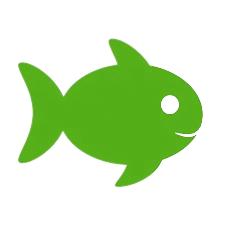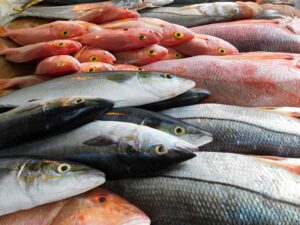Salmon is a type of fish that we are all familiar with. It has strong swimming abilities and firm flesh. As a delicious ingredient, it is often found on tables around the world.
Purpose of farmed salmon
However, wild salmon typically takes several years to hatch and grow into adult fish. If so many people worldwide were to consume wild salmon, it would be devastating for both the salmon species and the environment.
To be able to enjoy delicious salmon regularly, Farmed salmon emerged.

Conditions for farmed salmon
Oppdrettslaks can be bred and cultivated artificially in aquaculture facilities. This process usually takes place in specific water bodies, such as ocean cages, rivers, or lakes. These artificial settings provide favorable water quality and environmental conditions for salmon growth, including water temperature, oxygen content, and food supply.
Water temperature
During the hatching period of salmon, the water temperature is usually controlled between 4-10 degrees Celsius. This temperature is conducive to the hatching of salmon eggs and the normal development of fry. For juvenile salmon in the growth stage, they prefer an environment with a temperature of 8-15 degrees Celsius, as their appetite is most vigorous and they grow faster in this range. Adult salmon, in the mature stage, have greater adaptability and their preferred temperature varies depending on the species but generally falls between 6-20 degrees Celsius.
Oxygen content
Similar to water temperature, salmon in different growth stages have different oxygen requirements. This is because salmon need to take in oxygen for metabolism. Just like humans, the metabolism of fry is faster than that of adult fish, so young salmon require higher oxygen levels, typically ranging from 6 milligrams per liter to 9 milligrams per liter. Adult salmon, on the other hand, only need oxygen levels ranging from 5 milligrams per liter to 7 milligrams per liter.
Feed
All animals’ development processes depend heavily on food. Marine plankton, which includes algae, crustaceans, and mollusks, serves as the main food supply for wild salmon. Salmon also eats tiny fish, fish eggs, tiny shrimp, tiny crabs, and tiny clams. Salmon may feed as adults on bigger fish and mollusks like cod, flounder, and squid. These meals offer a variety of minerals and proteins essential to the growth of salmon. The use of wild salmon’s food as feed would have a huge influence on fish supplies since farmed salmon are far more plentiful than wild salmon. Reduced reliance on fish resources is required, together with the provision of feed that satisfies the nutritional requirements for salmon growth, to maintain environmental sustainability. The following four ingredients are frequently seen in salmon feeds:

*Fishmeal and fish oil:
Typically, little fish, fish that has been abandoned, or by-products of fish processing are used to make fishmeal and fish oil. They supply high-quality fat, protein, and minerals.
*Plant protein:
Because there are only so many fish resources available, the need for large-scale salmon farming cannot be satisfied by depending simply on leftover fish or fish byproducts. Salmon feed has a significant amount of plant protein, which helps to supply both protein and energy. Soy protein, soybean meal, and corn protein are examples of plant proteins that may be produced through crop cultivation. Salmon’s nutritional balance and health can be ensured by plant protein, which can supply amino acids and minerals that fishmeal and fish oil may lack. Plant proteins are also less expensive.
*Carbohydrates:
Corn, wheat, and beans are examples of sources of carbohydrates with a high energy density that salmon may eat to help them develop and metabolize correctly. Protein waste would result from using it as energy, despite the fact that it can. By supplying carbs, it is possible to preserve the usage of protein, ensuring that it is predominantly used for body tissue growth and maintenance rather than for energy. Additionally, the feed’s carbohydrates have a binding effect that helps create a homogeneous particle structure that is simple to absorb and digest. Additionally, they can make the meal more palatable and soluble, which makes it simpler for salmon to eat and digest other nutrients.
*Vitamins and minerals:
Vitamins and minerals are essential for the normal physiological functions of salmon. They play a crucial role in maintaining salmon’s metabolism, skeletal development, nervous system, and immune system. While wild salmon can obtain these essential vitamins and minerals from natural food sources, farmed salmon requires the addition of these substances to their feed to ensure comprehensive and balanced nutrition. Furthermore, increasing the levels of vitamins and minerals in feed can to some extent enhance its antioxidant properties, prolong shelf life, and prevent the loss and degradation of nutrients.
Process of salmon aquaculture
The process of salmon aquaculture generally includes hatching, rearing, growth, and harvesting.
Hatching

First, fish eggs need to be collected. These eggs are taken from mature salmon, which can be either wild or farmed. To ensure the health and survival rate of farmed salmon, damaged or unhealthy eggs are removed, and the remaining eggs are disinfected to prevent the spread of diseases. Once all the healthy eggs are selected, they are placed in hatching trays for incubation. The hatching trays provide suitable environmental conditions for egg incubation, such as a water temperature of 4-10 degrees Celsius. Since different eggs hatch at different times, during the early stages of incubation, lower water temperatures are maintained to slow down the development process, allowing more eggs to hatch around the same time for easier management and higher fry concentration.
In addition, the oxygen content is controlled within the range of 6-8 milligrams per liter. Generally, lower water temperatures result in higher oxygen solubility. Oxygen can be increased through methods like air injection and oxygen supply devices.
Lighting is also one of the factors that need to be controlled in the hatching trays. Soft lighting is typically used, avoiding both excessive brightness and darkness, as excessive light can damage the salmon’s eyes. Approximately 8-12 hours of lighting per day is provided, gradually increasing the illumination time and simulating natural daylight variations to help regulate the biological clock and metabolic activity of the eggs and fry. Common light sources include natural light, artificial lighting, and LED lights.
To simulate the natural environment, the hatching trays also require appropriate water dynamics, including water flow and intensity, to promote the development and dispersion of eggs and fry, as well as the distribution of feed and waste. However, water dynamics should only involve gentle flow or weak agitation to avoid adverse effects on the eggs and fry.
In a carefully controlled environment, the eggs go through differentiation, embryo development, and fry hatching. Once the eggs hatch into fry, they can be transferred to suitable environments for further growth, such as rearing tanks, ponds, flow-through systems, or marine net cages.
Rearing
After the salmon eggs hatch into fry, they enter the rearing phase. This is a critical stage because the newly hatched fry are still very fragile and require careful care to ensure their growth and healthy development.
Choosing suitable rearing containers is important. First, the capacity and size of the containers need to be determined based on the number and size of the fry, providing enough space for them to swim and grow freely, avoiding overcrowding. Additionally, the containers need to maintain stable water temperature, oxygen levels, pH, etc., so considering water circulation is necessary to keep the water fresh and clean. Moreover, the containers should be free from substances that could harm the fry. Semi-transparent or transparent materials are preferred as they allow observation of fry growth, facilitating the early detection of abnormalities. For example, if diseases are noticed, they can be treated or vaccines can be administered promptly. If water quality deteriorates, the containers can be cleaned and disinfected in a timely manner.
Finally, ensuring a food supply is important to ensure that the fry can obtain the necessary nutrients. During the rearing stage, the fry’s oral cavity and digestive system are not fully developed, so a greater amount of fine particles or powdered feed is used. These feeds have small diameters that can accommodate the fry’s oral size and digestive capacity. Additionally, during the early stages of fry growth, their protein requirements are relatively high, so the feed used should have a higher proportion of high-quality protein. Although fat is also an essential nutrient for salmon, the fat content in the feed for fry is not too high to avoid excessive fat accumulation and digestive issues.
Growth
Similar to the fry stage, controlling water temperature, oxygen levels, pH, and water quality stability, as well as preventing diseases, are still important during the growth stage of salmon.
The main difference from the fry stage lies in the change of feed. Just as teenagers consume more food than infants, adult salmon require a larger amount of feed to meet their growth and metabolic needs compared to fry. As the farmed salmon grows, its oral cavity and digestive system become stronger and can consume larger particles, so the feed transitions from small-diameter feed to larger-diameter feed. Additionally, during the growth stage, salmon’s growth rate is relatively slow, and their protein and fat requirements are lower. Therefore, the feed used during this stage has relatively low protein and fat content. This feed selection also helps avoid excessive fat accumulation and environmental issues in salmon.
Finally, depending on market demand, some fish farmers may need salmon to reach marketable sizes more quickly. In such cases, improvements in farming conditions and optimizing feed structures are necessary to promote the growth of salmon.
Salmon fry are usually obtained from hatcheries or fry suppliers and then transferred to aquaculture facilities. In these facilities, they are fed specific feeds to promote their growth and development. The duration of farmed salmon can vary based on the desired size and market demand.
Harvesting

The ultimate purpose of farming salmon is for human consumption or other uses, and the harvesting stage is the final stage of farmed salmon. After harvesting, it signifies the completion of the salmon’s growth and prepares it for sale or processing.
Mature salmon are typically removed from the aquaculture facilities through fishing methods, including the use of nets, traps, or other fishing tools to guide the salmon from the farming facilities into a concentrated area for harvesting. Then, the fish farmers classify the salmon based on the species, size, body shape, color, meat texture, fat content, and scale integrity to meet various purposes and market demands. High-quality salmon typically have good meat texture, vibrant color, and appropriate fat content.
Afterward, the salmon goes through processing steps, including descaling, gutting, cleaning, and portioning. The forms of salmon commonly seen in the market include fillets, steaks, or whole fish. After processing, the different forms of salmon are packaged and refrigerated for transportation and sale. Sales channels include fish markets, supermarkets, restaurants, and exports.
If there are specific requirements in an order, farmed salmon can be provided to retailers or consumers in a fresh form without undergoing freezing. If the salmon can be transported to the consumers’ location within a short period, it can also be sold as fresh, typically in regional markets where the salmon can be transported from the farm to the point of sale within hours or a few days.
However, for long-distance transportation or when long-term storage and extended shelf life are required, freezing is a good method to keep the salmon fresh and maintain its quality over a longer period, reducing spoilage and losses. This provides convenience for supermarkets, restaurants, and consumers to purchase and use salmon at any time. Sometimes, the demand for salmon faces uncertainty, making sales difficult to predict or experiencing seasonal fluctuations, and freezing is an essential preservation method.













